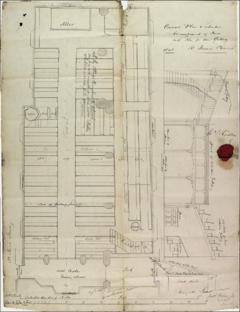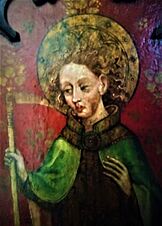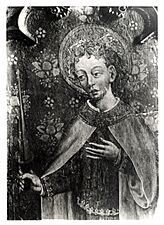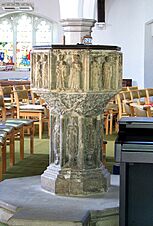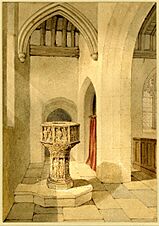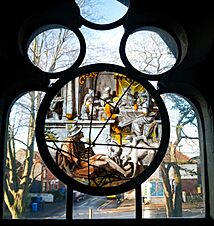St James the Less, Pockthorpe facts for kids
Quick facts for kids St James the Less |
|
|---|---|
| St James the Less, Pockthorpe, Norwich | |

View from the southwest
|
|
| Location | Norwich, Norfolk |
| Country | United Kingdom |
| History | |
| Dedication | Saint James the Less (officially Saints James the Less and James the Great) |
| Architecture | |
| Functional status | Puppet theatre |
| Heritage designation | Grade I listed (1954) |
| Architectural type | Perpendicular |
St James the Less, Pockthorpe is an old church building in Norwich, England. It was first mentioned in records in 1180. The church used to serve a small area of the city. Over time, the area it served grew to include Pockthorpe, a nearby village, and part of Mousehold Heath.
The church building was repaired in 1885. In 1973, it was taken care of by the Norwich Historic Churches Trust. For a while, it was a shelter for people without homes. Then, in 1980, it became the home of the Norwich Puppet Theatre.
The church is built in a style called Perpendicular Gothic. It uses materials like flint, stone, and brick. Inside, there's a tower supported by pillars. This tower is built within the church, not at the very end, which makes the west side of the building look a bit different. Many of the church's original items, like its old baptismal font and some 15th-century screen panels, are now in a nearby church called St Mary Magdalene, Norwich. This happened after St James the Less stopped being used for worship in 1972.
Contents
The Church's Story
Early History
St James the Less might have replaced an even older building. Archaeologists have found signs of a clay wall from the 11th or 12th centuries under the church's foundations. Like many old churches in Norwich, not much of the very first building has survived.

The church was first written about in 1180. It was also known as St James, Cowgate, or St. James at Barr-gates. It might be the church mentioned in the Domesday Book as "the church of Letha." The church was actually dedicated to two saints: St James the Great and St James the Less.
Archaeological findings suggest the church was built when the River Wensum was wider or more marshy than it is today. Pockthorpe, the nearby village, was named "little Thorpe" because it was part of an older area called Thorpe. In 1106, the land at Thorpe was given to Herbert de Losinga, who was the Bishop of Norwich. He likely also started the church and had power over it.
Changes Over Time
In 1368, the church was valued at £1 6s 8d. By 1535, its value had more than doubled. In the late 1400s, the church building grew into Cowgate, a street that used to be about 3 meters to the east.
During the English Reformation, the area served by St James grew. It took in the parish of St Catherine, which included a chapel dedicated to William of Norwich. William was a local boy who was murdered and buried on Mousehold Heath in 1137. The larger area included part of the heath and the village of Pockthorpe, which was across the River Wensum and outside the city walls.
19th Century Repairs
In 1841, the church needed a lot of repairs. It was in very bad condition. The Norwich Diocesan Association for Building and Enlarging Churches gave £100 to help. More money was raised from other people who cared about the church.
The repairs cost over £600. On October 9, 1842, St James reopened for services. The building was fully restored and looked very neat. They added 165 more seats by changing the pews and making the gallery bigger. The Bishop of Norwich even gave a beautiful altar cloth. The church was also changed and restored again in the mid-1800s and in 1885.
In the 1800s, Norwich grew a lot. Pockthorpe, where most of the church's people lived, became known for its extreme poverty and poor housing. In 1842, Barrack Street in Pockthorpe was described as having "mean" houses where the "poorer part of the citizens" lived. There were also problems with dirty water and a lack of clean running water.
20th Century and Today

It wasn't until the 1930s that the very poor housing areas, called slums, were torn down. St James's Church and a part of Norwich's old city wall are almost all that remain from before the Second World War.
The church is no longer used for religious services. It closed in 1972. In 1973, the Norwich Historic Churches Trust took care of the building. From 1972 to 1976, part of the building was used as a night shelter for people without homes.
Today, St James is a Grade I listed building, which means it's very important historically. It's also on a list of buildings at risk because there's a chance it could get worse quickly if nothing is done.
The building is now home to the Norwich Puppet Theatre. This theatre is special because it's completely dedicated to puppetry. The church was changed for its new use between January and March 1979. The main part of the church, the nave, was turned into an auditorium using old cinema seats. The chancel became the performance area. The theatre opened in 1980 and can hold 185 people. An extension was built in 1980 for storage and rehearsal space.
Church Design

The church's design style is Perpendicular Gothic. The main parts of the church, like the nave, chancel, and south aisle wall, are made of knapped flint, stone, and brick. The nave has three sections. The south aisle runs next to the nave and chancel.
At the west end of the nave, there's a fourth section separated by two pillars. These pillars help support the brick-topped tower, which has three levels. The tower was built inside the church, not at the very end, which makes the west side of the church divided. The top part of the tower was built in 1743.
At some point, probably between the 14th and 15th centuries, a porch was added. In the late 1400s, the west tower-bay and the north wall were rebuilt to add a staircase for the rood loft. There might be a wall painting from the 1500s on the north nave wall. A new aisle was built, and the chancel wall was rebuilt in the 1500s.
During the 1700s, a new south porch was built. This porch used to have stone figures on top, but only one is left now.
The original stained glass windows are from the 15th century. Most of them are in the Perpendicular style. The east window has older designs from the Decorated period. The windows were repaired in 1954 and 1960. Some roundels (small circular glass pieces) from a local glass collector were added then. Several of these are now at St Mary Magdalene, Norwich. This includes a 16th-century Flemish roundel showing the story of the rich man and Lazarus.
Original Items and Treasures
When the church closed, it still had one of its three original bells, made in 1625. The church's old records are kept at the Norfolk Record Office. In the 1700s, a historian named Blomefield described a Lady chapel in the church. He also wrote about many inscriptions on brass plates and tombstones.
Rood Screen
The church once had a beautiful rood screen with painted panels. Each panel showed a different saint. Records say the screen was "beautifully painted" in 1479.
The screen was taken apart in 1883. The panels were later owned by a kind person named Jeremiah Colman, who reportedly bought them for a shilling each from Norwich Market. Colman later arranged for the panels to be returned to the church. A new screen was made in 1946 for the panels that survived.
Historians have noticed that the panels from St James the Less are similar in style to panels from other churches in East Anglia. This group of screens is called the "Ranworth group." They are similar in how they were built and decorated.
Font
The church's carved stone baptismal font is shaped like an octagon. It shows the four Evangelists, the Apostles, and eight female saints. The underside is decorated with leaves and branches. It looks very much like the font at All Saints' Church, Norwich. The painted panels and the font were moved to St Mary Magdalene in 1946.
Medieval Cope
A special priest's robe called a cope that was originally from St James is now kept by the Norfolk Museums Service. This cope dates back to 1480. It was repaired in 1954 by experts in London. The robe is made of silk and velvet and has beautiful embroidery. It was once thought to be the oldest such garment still used in England. The cope was shown in an art exhibition in 2020.
The cope is decorated with double-headed eagles, flowers, and fleur-de-lys. It used to have a picture of the Assumption of Mary and two seraphs in the middle, but these were removed after the Reformation. You can still see a dark area on the velvet where they used to be. The cope was later taken apart and used as a table cover before being repaired in the late 1800s.
Church Leaders
The first known priest of St James was Sir Thomas Catlin, appointed in 1462. Other leaders of the church included Nicholas Gilman (1604–1626), John Barnham (1626–1662), William Herne (1735–1776), James Newton (1776–1811), Bell Cook (1826 –1843), Alfred Davies (1873–1896), Herbert Pitts (1929–1950), and Malcolm Menin (1962–1973).
| Name | Year of appointment | Notes |
|---|---|---|
| Thomas Stone | 1896 | St Mary Magdalene's, a smaller church linked to St James, was built in 1902–1903. |
| Charles Edward Osborne Griffith | 1904 | – |
| Herbert Benjamin John Armstrong | 1916 | – |
| Gerald Wilfred Fardell Howard | 1922 | – |
| Herbert Pitts | 1929 | He also looked after St Martin at Palace, Norwich, from 1944. Pitts was already a trained priest when he came to England from Australia. |
| John Harold Ferley | 1950 | He also looked after St Martin at Palace, Norwich (1950–1952). |
| Sidney Long | 1953 | He also looked after St Martin at Palace, Norwich (1953–1962). |
| Malcolm James Menin | 1962 | He also looked after St Martin at Palace, Norwich (1962–1974). He became the vicar of St Mary Magdalene in 1972 after St James closed. He later became a bishop in 1986. |


